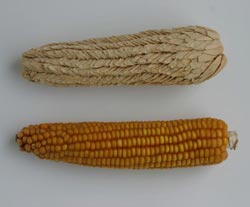Pod corn develops leaves in the inflorescences

Whereas the mature kernels in wild-type maize (below) sit naked on the cob, in pod corn (above), they are wrapped in individual leaf-like organs. © Grosardt, MPIPZ Cologne<br>
In a variant of maize known as pod corn, or tunicate maize, the maize kernels on the cob are not ‘naked’ but covered by long membranous husks known as glumes. According to scientists from the Max Planck Institute for Plant Breeding Research in Cologne and Friedrich Schiller University in Jena, this variant arises from the activity of a leaf gene in the maize cob that is not usually active there. Thus, pod corn is not a wild ancestor of maize, but a mutant that forms leaves in the wrong place.
Pod corn has a spectacular appearance that has fascinated naturalists for two centuries. In this maize variant, the kernels are wrapped in fine glumes which look like thin paper in their dried form and resemble a leaf sheath. The male flowers, which are arranged in a panicle at the end of the stem axis, are also surrounded by long glumes, and sometimes even develop kernels that can otherwise only be found in the cob. The pod corn leaves resemble those of the normal maize plant. Pod corn had a ritual significance for some Native American tribes and can therefore be found throughout the American continent.
The putatitive significance of pod corn for the domestication of maize has long been a matter of controversy. Some scientists believed pod corn to be a wild, precursor of the varieties with naked kernels common today. Others disagreed with this view – and they were right, as we now know. The wild ancestor of today’s common maize varieties is not pod corn but the unimpressive sweet grass teosinte.
Heinz Saedler, Günter Theißen and their colleagues have now discovered how the spectacular appearance of pod corn arises. Their findings reveal that this variant has nothing to do with the domestication of maize, but is a mutant that forms leaves in the wrong place. Genetic experiments from the 1950s provided important inspiration for the research. “We knew from the old crossing experiments that the mutation must consist of at least two genetic components that can be inherited separately. If just one component is inherited, the glumes that surround the kernels in this mutant are significantly smaller and less conspicuous than the glumes in mutants with both components. However, they are not as tiny as the glumes found in common maize plants in which the kernels sit naked on the cob,” explains Heinz Saedler from the Max Planck Institute for Plant Breeding Research.
The researchers succeeded in showing that the components in question are two copies of the same gene which are located in tandem on chromosome 4. Although the gene itself is intact in pod corn, the region that controls the transcription of the gene is damaged. As a result of this defect, spatial control of gene activity in the right plant organs is lost. Therefore, in its mutated form, this gene is also active in the cob and not only in the growing leaves. “The gene contains the information for a transcription factor. Through its ectopic activity in the male and female inflorescence, it controls a set of so called ‘target genes’ and hence a programme in the glumes that is normally reserved for leaf development and should not be active in the inflorescence. As a result of this erroneous activity, the glumes assume a leaf-like growth pattern and grow until the kernels are completely covered,” says Günter Theißen from the University of Jena.
These findings also explain the existence of pod corn with smaller glumes. “The extent of this phenotype depends on whether there are one or two copies of the damaged gene on the chromosome and whether the plant is homozygous or heterozygous for this gene,” says Theißen. “If one gene copy is present, the effect on the leaf development programme is only half as strong as it is in one with two copies. Therefore this genetic effect is additive. The gene dosage decides, on the strength of the mutant phenotype.” Theißen and his colleagues were also able to show that the mutated gene belongs to an entire family of developmental control genes known as the MADS-box gene family. Other representatives of this family control other development processes in the plant.
Contact
Professor em. Dr. Heinz Saedler
Max Planck Institute for Plant Breeding Research
Phone: +49 22 150-620
Email: saedler@mpiz-koeln.mpg.de
Contact
Professor Dr. Günter Theißen
Friedrich-Schiller-Universität
Phone: +49 36 4194-9550
Email: guenter.theissen@uni-jena.de
Original publication
Luzie U. Wingen, Thomas Münster, Wolfram Faigl, Wim Deleu, Hans Sommer, Heinz Saedler, Günter Theißen
Molecular genetic basis of pod corn (Tunicate maize)
PNAS 2012; online publication, April 18, 2012, doi:10.1073/pnas.1111670109
Media Contact
More Information:
http://www.mpg.de/5755791/pod_corn_leaves_inflorescencesAll latest news from the category: Agricultural and Forestry Science
Newest articles

Magnetic tornado is stirring up the haze at Jupiter’s poles
Unusual magnetically driven vortices may be generating Earth-size concentrations of hydrocarbon haze. While Jupiter’s Great Red Spot has been a constant feature of the planet for centuries, University of California,…

Cause of common cancer immunotherapy side effect s
New insights into how checkpoint inhibitors affect the immune system could improve cancer treatment. A multinational collaboration co-led by the Garvan Institute of Medical Research has uncovered a potential explanation…

New tool makes quick health, environmental monitoring possible
University of Wisconsin–Madison biochemists have developed a new, efficient method that may give first responders, environmental monitoring groups, or even you, the ability to quickly detect harmful and health-relevant substances…



